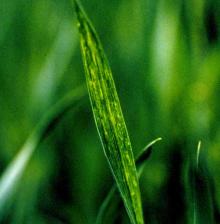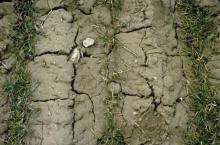Cause Wheat streak mosaic virus, a potyvirus vectored by an eriophyid mite, Aceria tulipae. The virus attacks and overwinters in wheat, oat, barley, and rye, and a large number of wild grass genera including Bromus (cheatgrass), Hordeum, Lolium, Agropyron, and Poa. The disease usually is in late-harvested or irrigated areas where wheat seedlings emerge before the current year's crop has been completely harvested. The disease spreads when mites move from the harvested field into the young cereal. Nitrogen applications can affect the incidence of both the virus and mites.
Symptoms Symptoms usually first appear on the field's edge or where seeded waterways pass through the field. Mottled stripes run up and down the leaves. Leaf edges all cup up and roll to the center of the leaf. If the lower leaf is examined carefully, the eriophyid mite vector frequently can be observed.
Cultural control
- The most effective control is to have a host-free period between each cereal crop.
- Destroying volunteer wheat and seeding late help reduce the disease.



